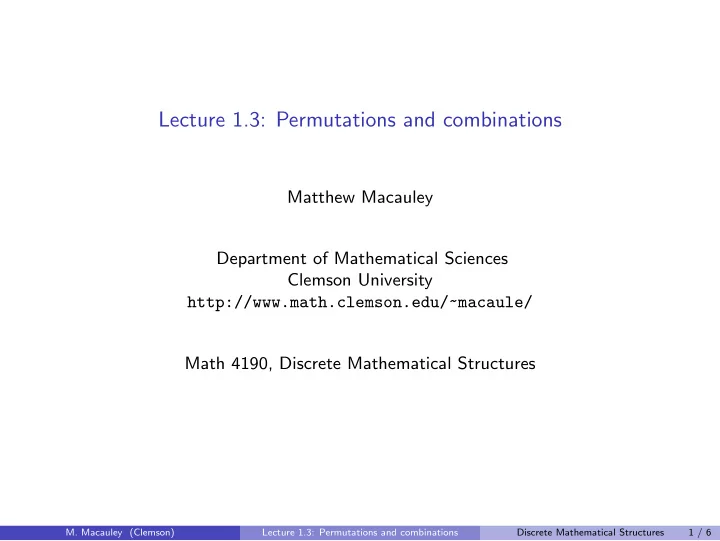

Lecture 1.3: Permutations and combinations Matthew Macauley Department of Mathematical Sciences Clemson University http://www.math.clemson.edu/~macaule/ Math 4190, Discrete Mathematical Structures M. Macauley (Clemson) Lecture 1.3: Permutations and combinations Discrete Mathematical Structures 1 / 6
How to count Recall that combinatorics is the mathematical field of counting things. There are many techniques for how to count, but one must be careful about what is allowed, and what counts as “different”. For example, consider the following basic counting problems: How many ways can you order lunch from a choice of 10 sandwiches and 3 beverages? How many ways can you get 3 drinks from a vending machine with 10 choices? How many ways can you answer a 10-question true/false questionnaire? How many ways can you rank 10 candidates? (no ties allowed) How many ways can you rank 10 candidates? (ties allowed) How many ways can you pick 3 people from a group of 10? How many ways can you pick a president, vice president, and secretary from a group of 10? How many ways can you break a group of 10 people into two nonempty groups? M. Macauley (Clemson) Lecture 1.3: Permutations and combinations Discrete Mathematical Structures 2 / 6
Independent events One of the “easiest” things to count are the number of possibilities of events when the outcomes are independent. Example Suppose we flip a coin and roll a 6-sided die. How many outcomes are there? Let C = { H , T } and D = { 1 , 2 , 3 , 4 , 5 , 6 } . The set of outcomes is � � C × D = ( H , 1) , ( H , 2) , . . . , ( H , 6) , ( T , 1) , ( T , 2) , . . . , ( T , 6) and this has size 12. Example How many license plates can you make with 3 letters followed by 3 numbers, e.g., ABC-123 How does this number change if repetitions are not allowed? M. Macauley (Clemson) Lecture 1.3: Permutations and combinations Discrete Mathematical Structures 3 / 6
Independent events Consider a quiz with four true/false and three multiple choice questions, (a)–(e). The number of possible ways to answer the quiz is 2 · 2 · 2 · 2 · 5 · 5 · 5 = 2 4 · 5 3 = 2000 . Proposition If A is a finite set, then its power set has cardinality |P ( A ) | = 2 | A | . Proof Imagine a true/false quiz, where for each element x ∈ A , we ask: Should we include x in our subset? Each of the 2 | A | possible ways to answer this quiz uniquely determines a subset (i.e., an element of P ( A )), and every subset can be described in this way. � Sometimes, the power set of A is denoted 2 A , even if A is infinite. M. Macauley (Clemson) Lecture 1.3: Permutations and combinations Discrete Mathematical Structures 4 / 6
Permutations How many ordered arrangements of a , b , c are possible? Answer . 3! := 3 · 2 · 1 = 6 : abc , acb , bac , bca , cab , cba . Each such arrangement is called a permutation. In general, there are n ! permutations of n distinct letters. Example A baseball (batting) lineup has 9 players. (a) How many possible batting orders are there? (b) How many choices are there for the first 4 batters? (c) Suppose the team actually has 15 players. How many batting orders are there? Theorem The number of possible permutations of k elements taken from a set of n elements is k − 1 n ! � P ( n , k ) := n · ( n − 1) · ( n − 2) · · · ( n − k + 1) = ( n − j ) = ( n − k )! . j =0 M. Macauley (Clemson) Lecture 1.3: Permutations and combinations Discrete Mathematical Structures 5 / 6
Combinations Combinations are like permutations, but order doesn’t matter. Examples (a) How many ways are there to choose 9 players from a team of 15? (b) All 15 players shake each other’s hands. How many handshakes is this? (c) How many distinct poker hands can be dealt from a 52 card deck? Definition The number of ways to choose k objects from a set of n is denoted � � n k !( n − k )! = P ( n , k ) n ! C ( n , k ) := = “ n choose k ” . k k ! Recall that 0! = 1. Properties of combinations � n � n � � i. = k n − k � n � n � � ii. = = 1 0 n � n � iii. = n . 1 M. Macauley (Clemson) Lecture 1.3: Permutations and combinations Discrete Mathematical Structures 6 / 6
Recommend
More recommend